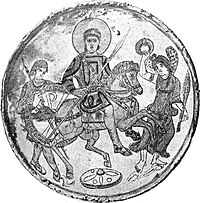
Back Christusmonogram Afrikaans كاي رو Arabic Хрызма Byelorussian Хризма Bulgarian Hi-ro BS Crismó Catalan Kristův monogram Czech Christusmonogramm German Χι Ρο Greek Crismón Spanish

The Chi Rho (☧, English pronunciation /ˈkaɪ ˈroʊ/; also known as chrismon[1]) is one of the earliest forms of the Christogram, formed by superimposing the first two (capital) letters—chi and rho (ΧΡ)—of the Greek ΧΡΙΣΤΟΣ (rom: Christos) in such a way that the vertical stroke of the rho intersects the center of the chi.[2]
The Chi-Rho symbol was used by the Roman Emperor Constantine the Great (r. 306–337 AD) as part of a military standard (vexillum). Constantine's standard was known as the Labarum. Early symbols similar to the Chi Rho were the Staurogram (![]() ) and the IX monogram (
) and the IX monogram (![]() ).
).
In pre-Christian times, the Chi-Rho symbol was also used to mark a particularly valuable or relevant passage in the margin of a page, abbreviating chrēston (good).[3] Some coins of Ptolemy III Euergetes (r. 246–222 BC) were marked with a Chi-Rho.[4]
Although formed of Greek characters, the device (or its separate parts) is frequently found serving as an abbreviation in Latin text, with endings added appropriate to a Latin noun, thus XPo, signifying Christo, "to Christ", the dative form of Christus,[5] or χρ̅icola, signifying Christicola, "Christian", in the Latin lyrics of Sumer is icumen in.

- ^ From a supposed Middle Latin crismon), specifically applied to the "Chrismon of Saint Ambrose" in Milan Cathedral. Crismon (par les Bénédictins de St. Maur, 1733–1736), in: du Cange, et al., Glossarium mediae et infimae latinitatis, ed. augm., Niort: L. Favre, 1883‑1887, t. 2, col. 621b. "CRISMON, Nota quæ in libro ex voluntate uniuscujusque ad aliquid notandum ponitur. Papias in MS. Bituric. Crismon vel Chrismon proprie est Monogramma Christi sic expressum ☧"; 1 chrismon (par les Bénédictins de St. Maur, 1733–1736), in: du Cange, et al., Glossarium mediae et infimae latinitatis, ed. augm., Niort : L. Favre, 1883‑1887, t. 2, col. 318c Archived 2016-08-26 at the Wayback Machine.
- ^ Steffler 2002, p. 66.
- ^ Southern 2001, p. 281; Grant 1998, p. 142, citing Bruun, Studies in Constantinian Numismatics.
- ^ von Reden 2007, p. 69: "The chi-rho series of Euergetes' reign had been the most extensive series of bronze coins ever minted, comprising eight denominations from 1 chalkous to 4 obols."
- ^ For example as inscribed on the monumental brass of Thomas de Camoys, 1st Baron Camoys (d.1421) in St George's Church, Trotton, Sussex, England